What is B2B marketing: Meaning, Tools and Trends
Summer Nguyen | 03-17-2025
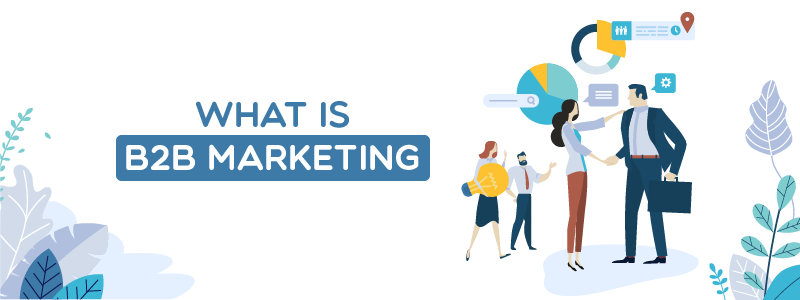
The B2B business is having a changing phrase where they have to satisfy the new generation of customers. The typical direct communication between sales and prospects or dinner and present will no longer suitable for the Millenials. Instead, the growth of B2B ecommerce will take place significantly in the future which will increase to exceed the B2C sales.
How can you expose better to the Y Generation? Which medium should B2B find to approach customers? How can the B2B relationship be maintained and strengthen?
I believe these questions will be solved with effective B2B Marketing.
This article is going to dive into all the general concepts of B2B marketing. Stay tuned to my content to refresh your knowledge about B2B marketing and learn about the recent trend and tool of Business to Business marketing.
What is B2B marketing?
B2B marketing, which can be called as Business-to-Business marketing, is defined by Linkedin as the activities of studying and managing relationships with another business or organization. It may sound quite similar to consumer marketing but it is totally different when you take a closer look in some aspects of business marketing.
These primary characteristics can be their target clients, order values, their customer demand, business relationships which will be further analysed in the below subsection:
B2B market
First off, it can be easily guessed that the average value of a B2B transaction is more significant than the average value of B2C transaction. However, to know the actual size of this market, statistics will do a better job than plain estimation. Shopify claims that the B2B market size is over two times bigger than the B2C market by 257.4 percent.
For business marketing, marketers focus mostly on personal selling instead of advertising on TV or newspaper to gain potential buyers. The only marketing activities they will execute mostly will be poured in trade journals and direct mail. However, in the article of B2B sales, I had indicated that B2B transaction has changed when Milleniums arrived. Most decision makers which are Millenials want to take the initiative in researching their business input result. To do so, they will mostly to search online to collect information to find valuable resources. As a result, B2B businesses who develop virtual marketing will have higher chance to expose with potential buyers. With the interest to use B2B services, you will attain a great number of buyers products/ services not only in local areas but also beyond national borders.
Therefore, B2B marketing needs to be paid with more attention to online marketing. The most important question right now is how to go beyond national borders? - Or how to market successfully?
Who are your target prospects?
The B2B corporation often being considered a niche market. B2C businesses, the target customer is not consumers but businesses. They are a team of buying influencers who gain years of experience as decision maker for their firms. They will purchase not for themselves but for the best interest of the whole firm. Their decisions based on the pros and cons of the possible solution to decide without any impulse to purchase.
In the modern marketing environment, they will find your business via educational content and accepted to use your business products/ services depend on the value you provide for them. To market B2B buyers, you can create a direct persona which is essential to create a precise Customer Persona.
Importance of brand name for B2B
Credibility and trust is also an important criteria that brings customers to work with your company. For B2B professional buyers, they want professional working relationship that brings high quality and skills. To sway the customers, firms need to polish their professionalism, dedication to win customer trust.
It is an important aspect that needs to be created by B2B marketing. The main reason is because the transactions is not one time only, it is a long term relationship which need to claim by brand name, their reputation in the field. In another way to explain is buyers want inertia which are the tendency to remain everything unchanged.
Hence, building a brand name by marketing method is vital for businesses to widen their popularity in global scales. Unlike the past, business sellers now have the chance to reach out to any buyers and vice versa. Although it means that you will meet tough competitors, there is no opportunity that does not include risks.
Related Post: Guide to Boost Sales with B2B Company Accounts Magento 2
The modern B2B marketing
Nowadays, the purchase process of purchasing is changing significantly with the interference of computer innovation. Inbound marketing used to be the fundamental way to attract business buyers. However, things have changed and also business should not drag their heels when changes are happening right in front of them. As I the changes of B2B sales is taking place, marketing method will be influenced as well. To explain further, I want to talk more about methods for B2B marketing which divided into 2 main activities:
- Outbound marketing- which can be called as interruption marketing
- Inbound marketing
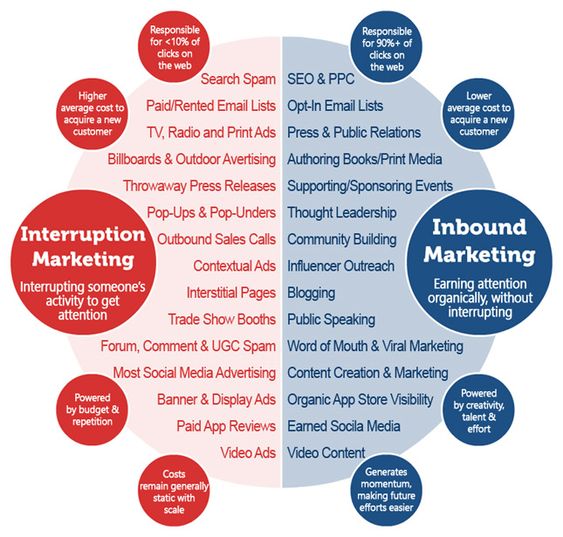
After reading the activities of inbound and outbound marketing which one do you prefer? Is it Inbound? As I get passed a fascinating Inbound and Outbound bound article, the writer interpret the Inbound method as a “hip trend” for the fashionable marketer to choose right now. The trend is created and influenced by a reason.
In my opinion, it is created based on its fundamental advantages that inbound creates for the business. Although it is hard to measure the effectiveness of inbound marketing, this strategy gives brand awareness and provides value to business beloved prospects. A different reason for businesses to follow and worship this trend is because is a money-saving and brilliant method to interact with customers. Rather than applying outbound, it is perfect for low-budget eCommerce stores.
Well, does inbound marketing B2B businesses worth aiming for?
I believe yes, which means businesses should remain their outbound marketing?
I do not think so! Unlike retail businesses, the firm not only serves Millennials, but they also serve the older generation. In the article “What is B2B sales”, I have mentioned that there are 73% of decision-makers are now Millennials. With 27% of non-Millennials still remain the decision decider, interruption marketing is also essential as well. For the X Generation and the Baby Boom Generation, the outbound strategy will be more appropriate. It is because most of them are still not acclimate to changes in technology. Thus, outbound marketing has also effective to strengthen brand awareness when the target is another business (B2B marketing).
Therefore, the B2B marketing team should make special research and do experiments with not one method but combine both Inbound and Outbound marketing with experimentation to find which one has more significant effects on your market.
How to Create a B2B Marketing Strategy
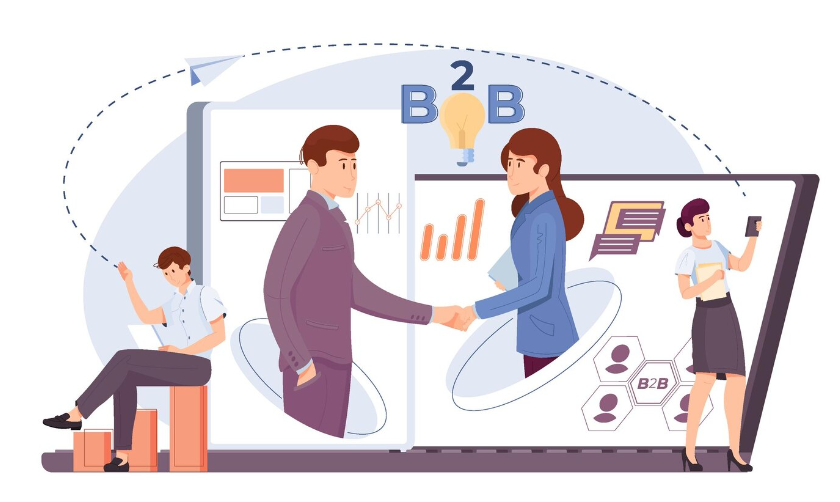
Nowadays, businesses have difficulty attracting and retaining customers in a competitive environment. To create a B2B strategy that works, you need to plan, execute, and manage it carefully. This is an overview of the steps B2B businesses take to differentiate themselves from others in the market.
Step 1: Build an Overarching Vision
Before you start planning your B2B marketing strategy, you need to have a clear and compelling vision of what you want to achieve and how you want to position yourself in the market. This vision will guide your marketing decisions and actions and help you convey your value to your customers.
To build your overarching vision, you need to:
-
Define your mission, vision, and values as a B2B company: Your mission is your purpose, your vision is your aspiration, and your values are your principles. These elements define who you are, what you do, and why you do it. They also help you adjust your marketing strategy with your business strategy and create a consistent and authentic brand identity.
-
Identify your unique selling proposition (USP) and how you solve your customers’ problems: Your USP is what makes you different and better than your competitors and how you deliver value to your customers. It is the core message that you want to convey to your target market and the reason why they should choose you instead of others. To create your USP, you need to understand your customers’ problems, needs, and desires and how your solution can solve them effectively.
-
Set SMART (specific, measurable, achievable, relevant, and time-bound) goals and objectives for your B2B marketing strategy: Your goals and objectives are the outcomes that you want to achieve with your B2B marketing strategy and the indicators that you will use to measure your progress and success. They should be SMART, meaning that they should be specific, measurable, achievable, relevant, and time-bound.
For example, a SMART goal could be: “Increase website traffic by 50% in the next 6 months.”
Step 2: Identify Your Market and Buyer Persona
When you have your overarching vision, you need to define your target market and buyer persona. Your target market is the group of potential customers that you want to reach and help with your B2B marketing strategy. Your buyer persona is a semi-fictional representation of your ideal customers based on real data and insights.
To define your market and buyer persona, you need to:
- Segment your market based on criteria such as industry, size, location, budget, etc: Market segmentation is the process of dividing your market into smaller and more homogeneous groups based on various characteristics and criteria.
This helps you tailor your marketing strategy to the specific needs and preferences of each segment and increases your chances of attracting and converting them. For example, you can segment your market by industry (ex: healthcare, education, manufacturing, etc.), size (ex: small, medium, large, etc.), location (ex: country, region, city, etc.), budget (ex: low, medium, high, etc.), etc.
- Create buyer personas for each segment, based on their demographics, psychographics, pain points, goals, and decision-making process: Buyer personas are detailed profiles of your ideal customers that describe their demographic information (ex: age, gender, education, job role, etc.), psychographic information (ex: personality, values, attitudes, motivations, etc.), pain points (ex: challenges, frustrations, problems, etc.), goals (ex: aspirations, desires, outcomes, etc.), and decision-making process (ex: stages, influencers, criteria, etc.).
Buyer personas help you understand your customers better and create more relevant and personalized marketing messages and offers for them.
- Use tools such as surveys, interviews, analytics, and social media to research your market and buyer persona: To create accurate and realistic market segments and buyer personas, you need to collect and analyze data and feedback from various sources and methods.
You can use tools such as surveys, interviews, analytics, and social media to gather qualitative information about your market and buyer persona, such as demographics, psychographics, pain points, goals, behavior, preferences, etc.
Step 3: Find Effective B2B Marketing Strategies and Channels

After you have defined your market and buyer persona, you need to identify the best B2B marketing tactics and channels to reach and engage them with your marketing message and offer. B2B marketing tactics and channels are the methods and platforms that you use to execute your B2B marketing strategy and achieve your goals.
To identify your B2B marketing tactics and channels, you need to:
-
Conduct a SWOT (strengths, weaknesses, opportunities, and threats) analysis of your current marketing situation: A SWOT analysis is a strategic tool that helps you evaluate the internal and external factors that affect your marketing performance and potential. Strengths and weaknesses are the internal factors that you can control, such as your resources, capabilities, and reputation. Opportunities and threats are external factors that you cannot control, such as your market trends, customer needs, and competitor actions.
-
Research your competitors and their marketing strategies: Competitor research is the process of analyzing and learning from your direct and indirect competitors in the market and how they market their products or services to your target audience.
-
Choose the most effective and relevant B2B marketing tactics and channels for your target market and buyer persona, such as content marketing, email marketing, social media marketing, SEO, PPC, webinars, events, etc: B2B marketing tactics and channels are the methods and platforms that you use to execute your B2B marketing strategy and achieve your goals.
There are many B2B marketing tactics and channels available, but not all of them are suitable or effective for your target market and buyer persona. You need to choose the ones that match your marketing objectives, budget, resources, and audience preferences.
Step 4: Generate Assets and Implement Campaigns
It’s time to put a plan into practice when you have it in place. You should use the best methods for each channel in your strategy. It would help if you had a creative way, helpful information, smart targeting, and strong calls to actions to make your campaigns successful.
Step 5: Measure and Enhance Performance
This is how you maintain ongoing processes and achieve your objectives. In essence, you want to find out what makes your content successful or unsuccessful.
Once you know this, you can make smarter decisions about how to spend your time and money. The more attentive you are to analyzing your data and using your insights, the more likely you are to keep improving and exceeding your targets. Even with a reliable research base, creating content and campaigns involves a lot of uncertainty until you have enough data on how your audience engages and converts.
It’s necessary to use data to find the best channels, topics, and media for your message and then focus on them. At the same time, remove or change anything that doesn’t work well.
6 differences between B2B and B2C marketing

B2B and B2C marketing are two different approaches to marketing products or services to different types of customers. Here are six key differences between B2B and B2C marketing:
Target audience
B2B marketing targets other businesses as customers, while B2C marketing targets individual consumers. B2B customers are usually more rational, informed, and price-sensitive than B2C customers, who are more emotional, impulsive, and brand-loyal.
Sales cycle
The sales cycle in B2B marketing is longer and more complex, with multiple decision-makers involved. B2B customers need more information, education, and persuasion before making a purchase.
B2C marketing, on the other hand, has a shorter and simpler sales cycle, with fewer decision-makers. B2C customers often make purchase decisions based on convenience, preference, and impulse.
Relationship building
In B2B marketing, building strong relationships with other businesses is crucial, as it can lead to long-term partnerships. B2B marketers need to provide consistent value, support, and trust to their customers.
In B2C marketing, the focus is more on building brand loyalty with individual consumers. B2C marketers need to create memorable experiences, emotional connections, and personalized offers to their customers.
Messaging
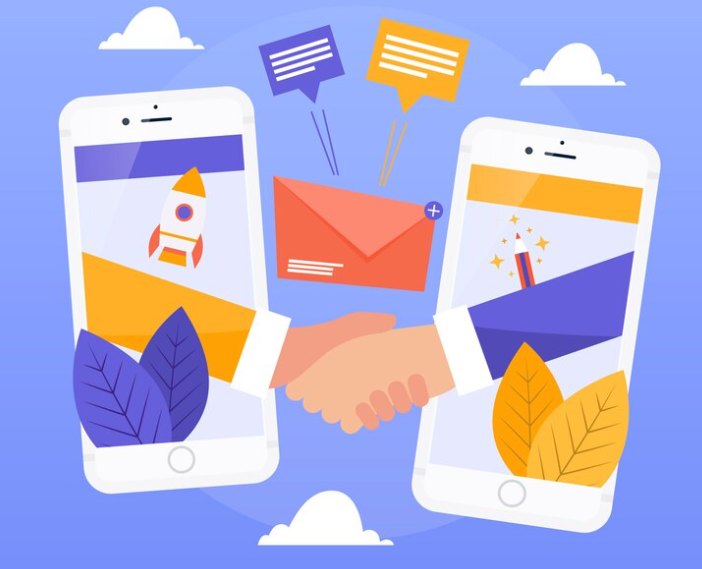
The messaging in B2B marketing should be more informative and educational, as businesses are looking for solutions to specific problems. B2B marketers need to highlight the features, benefits, and ROI of their products or services and use facts, data, and testimonials to support their claims.
The messaging in B2C marketing should be more emotional and appealing, as consumers are looking for products or services that satisfy their wants and needs. B2C marketers need to emphasize the value, quality, and uniqueness of their products or services and use stories, images, and humor to attract their customers.
Channels
B2B marketing often uses more professional channels like LinkedIn, email, and trade shows to reach other businesses. B2B marketers need to use these channels to communicate their expertise, credibility, and authority and to generate leads and conversions.
Alternatively, B2C marketing often uses more consumer-oriented channels like social media, television, and print ads to reach individual consumers. B2C marketers need to use these channels to increase their brand awareness, reach, and engagement and to drive traffic and sales.
Metrics
B2B marketing often uses metrics like leads, conversions, revenue, and ROI to measure its performance and success. B2B marketers need to use these metrics to evaluate their marketing effectiveness, efficiency, and profitability and to optimize their marketing strategy.
B2C marketing, on the other hand, often uses metrics like impressions, clicks, views, and likes to measure its performance and success. B2C marketers need to use these metrics to evaluate their marketing reach, exposure, and popularity and to improve their marketing tactics.
Specific Examples of B2B Marketing
There are some great B2B marketing strategies out there that you can learn from. If you want to create your own effective way to get new clients, it’s a good idea to explore some of these strategies and get inspired.
DatAvail

Entertainment is considered a compelling strategy for attracting new clients. DatAvail used this advantage to create a plan effectively. Their innovative creation, Datavailopoly, strategically targeted potential B2B partners, offering a unique method for engagement.
Datavailopoly is a board game for Database Administrators (DBAs) following Monopoly’s rules. It is a smaller game version that was made especially for them.
To get this game, people need to share information about a person who might need database services. This is considered a smart way for the company to get more social media attention, generate more leads, and improve their email marketing results.
Lenovo
Lenovo created an innovative marketing campaign known as the Users Happen video series, showcasing remarkable hard-to-believe stories related to laptop repairs.
This collection of videos not only entertained but also shed light on the diverse challenges users face with their devices. From accidental drops to liquid spills, Lenovo’s commitment to providing support ensures users receive prompt assistance regardless of the mishap.
One of the campaign’s notable strengths lies in its portrayal of various buyer personas who rely on Lenovo hardware. By highlighting real-life scenarios, Lenovo effectively connects with its audience, demonstrating an understanding of their needs and concerns. This personalized approach is impressive with potential clients, encouraging a sense of trust in Lenovo’s brand.
SnapApp
SnapApp strategically makes use of diverse content formats, including personality tests, polls, and calculators, to engage its audience.
Moreover, the company takes the lead in innovative B2B marketing strategies, illustrated by its notable initiative, ‘The Reason for the Season.’ This comprehensive year-long campaign is implemented carefully to address pressing marketing challenges. Particularly, it is necessary for generating fresh content in the shortage of creative inspiration.
Furthermore, abundant resources were crucial to its success, ranging from interactive webinars to insightful workbooks and guides. This approach emphasizes meaningful engagement with audiences and solves marketing problems effectively in the digital marketing landscape.
Tools for B2B marketing
Inbound Marketing
SEO
SEO is recognized by 59% of B2B marketers as the biggest impact on their lead generation goals. The customer will start their independent searching process with a searching tool from Bing, Yahoo, Google with a topic.
By using advertisement or improving SEO ranks, the store will appear on the first page of the search results. This will help the businesses to gain advance when approaching with the customer before the competitors do.
Content
This is a crucial material for permission marketing. Different from outbound marketing, the content you create on your blog and websites instead of spreading messages out there will bring more customers to the storers sites.
These contents need to meet some standard to receive the above benefits. Firstly, the information should be highly informative and captivate for the customers. If your content achieves both of the requirements above, your online stores will have more traffic from customers who actually want to learn more about your products on their own motives.
In addition, the readability of the content should be noticed as well. The store needs to mitigate or abandon completely all the “technical words” of specific fields. The more engaging the customer can have with the content, the more customers will come to the store.
Excellent blogs that bring benefits to the buyers will help the store to have a higher search rank to attract customers to come to the store and increase conversion rates.
Video
Video is a unique way to educate your prospects with lively images and verbal language instead of normal method. The content you create should be useful, timely, and relevant.
Unlike written blogs, videos take more time and resources to create. If you produce the right content with colorful and attractive explanations, the content will be your pied piper that mesmerize buyers to your store effectively.
Social media
With social media, the store will enhance communication to become faster.
To be clear, although B2B businesses serve the niche market, more social interaction still benefits the firm to strengthen customer relationships more frequently. One of the noticeable issues, when B2B firms go online, is cold order. B2B relationship is a long term commitment when the store wants.

For offline orders, B2B often maintain customer relationship between the bulk buyers and sales reps. The sales department makes contact with the buyers frequently to take care, support, and notice about store promotions that businesses can maintain relationships effectively.
On the other hand, for online orders, businesses will actively order from the sites so it is quite cold when there is little human contact. Therefore, you as an online B2B firm need to find different ways to contact the buyers. And, social media is not a bad idea. The communication builds up from comments and virtual interaction which is much faster than offline methods. In addition, social media communication provides plenty of room for strong communication with customers and visitors.
Besides, you need to orient your direction from the beginning. It is not solely to increase the followers on your sites, but also encourage them to become a supporter for your brand.
Mobile marketing
Mobile friendly has been considered as an important criterion for Google to assets websites for years. It is also important for B2B sites to appear on a higher rank than competitors. According to Campaign monitor, the B2B companies do not pay attention to building mobile experience. Therefore, firms can invest more in this ideal area to make your marketing activities more unique and seamless on smartphones which are the most popular and convenient communication means.
Outbound marketing
Email marketing
Without having sellers directly visits customers, emails marketing will be suitable to follow up with the client in the long run. It is the key to increase the customer retention rate. However, the method needs to process properly with some factors:
- Timing is essential: Send emails regularly for your customers.
- Engage customers more: your brand personality in your email. Don’t be afraid of injecting a bit of humor.
- Add in appealing offers: Including a “welcome gift” is certainly a good win to earn your customer’s affection. When your customers feel welcomed, the relationship of the firm with your client will strengthen the relationships.

Besides email marketing, there are other tools:
- Telemarketing
- PPC ads
- Tradeshow
- Print ads
- Press releases
With frequent contact, you might have already familiar with these tools, so I would not link up any extra information about these resources.
Looking B2B Marketing Solutions for Magento 2 stores? Take it here!
The trend of B2B marketing
You have understand more about B2B marketing meaning and the direction that B2B marketing is changing.The potential sales of B2B eCommerce in the US will climb up to $1,326 billion in the year 2023. With the high potential market, marketers need to pay more attention to generate high quality leads for your business to increase sales. To do so, I would like to provide some valuable and reliable statistics to see the changing pattern of the current marketing trend.
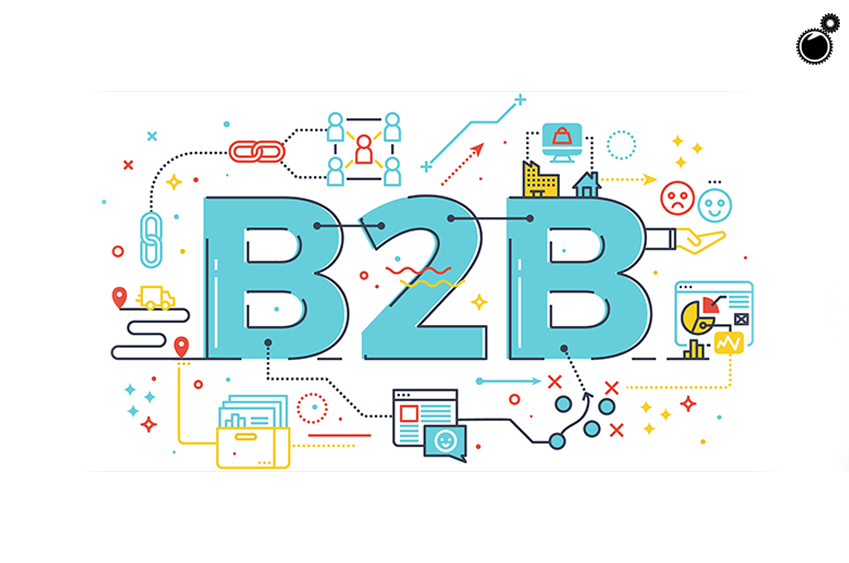
The projection of Forrester’s Digital Marketing Forecast estimated the budget for marketing will grow by 5.8% to 17.3% from 2016 to 2021. Although the aforementioned figures include both B2B and B2C, the result is significantly occupied by the B2B area.
SEO statistics
- 57% optimize SEO can create more leads than other Marketing methods (Junto, 2017)
- 89% of decision-makers utilize the internet to make research for B2B search process (Google, 2015)
- 60% of adults in the US search about local searches on local services or product information via tablets and smartphones (Google, 2014).
- 50% of researchers on mobile phones to find local businesses to search for business addresses (Google, 2014).
Via these figures, you can see optimizing the local search engine is essential. It will be a great tool to help businesses, especially for B-to-B enterprises. The local client will easily find the company through a local search.
The development of content marketing
For businesses that want to differentiate your firm with other competitors in the environment, you can conduct more video content. In detail, the State of Inbound Report 2018 has done research and gain fascinating insights. As you can see in the bar chart below, it indicates that the usage in visual content has been increased significantly from 2018 to 2019 by 64%.
Also, B2B marketers should not abandon the written contentas the information shows that successful marketers still prioritize this content format. In detail, the trend now is creating content in long-form which is above 1000 words. The in-depth content which brings value to the reader is now a trend that should be adapted well.
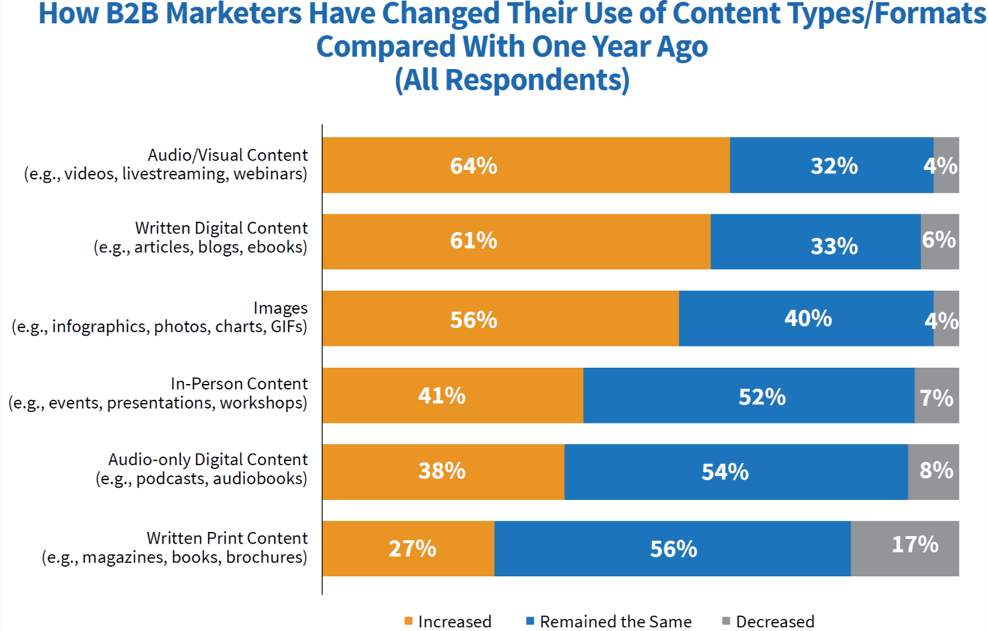
Subsequently, social media for B2B also have a noticeable trend. As there are so many social sites available online, you need to stay focused on some minor which can generate you as much lead as possible. Based on the statistics collected by LinkedIn, 80% of social media lead is gathered from LinkedIn. In addition, LinkedIn drives 50% of traffic for B2B blogs and sites which is more than Facebook and Twitter combined. Therefore, it will be beneficial for the store to stay focus to have frequent updates on LinkedIn first hand before other social media.
Other than LinkedIn, Facebook and Twitter are the runner up for the most popular social media channels being used by B2B marketers with 6.73% and 12.73% accordingly.

What B2B buyers expect?
As the B2B customer’s demand will keep changing, the enterprise should constantly upgrade buying experience to match satisfy buyers. The daily experience when buying in a retail ecommerce store is influencing the consumption pattern of B2B professional buyers. Thus, it causes some significant demand which B2B enterprise should stay focus and optimize:
- 96% of customers want content from the leaders of B2B industry (Demand Gen Report, 2016)
- 80% of business buyers from the United States want to experience the same buying experience of B2C (Demand Gen Report, 2016)
- 80% of bulk buyers want to have real-time experience (Salesforce Research)
Based on these trends above, we can assure that the B2B buyers want to be served in real-time on a personal level.
Summary
In a nutshell, B2B marketing needs determination and consistency to build up your reputation on the market. To do so, B2B sellers should increase the quality of your sites and your information to increase credibility so prospects can buy from you in the long run.
As there will be no one size fits all solution, enterprises can explore their creativity with the tools like Content, Video, Email marketing, SEO, Mobile marketing,… to differentiate with other competitors to find the suitable tool for them. You need to try new methods to finaly achieve the best results. For B2B firm who is developing Magento store site, it is best to find extension to market your business. Because a firm cannot grow with fate, just take control and take action to grow your business with us.








